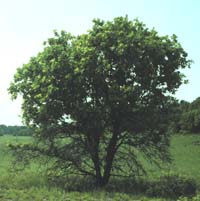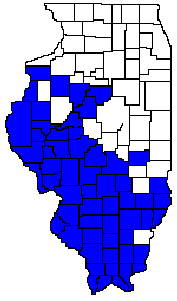 |
| Blackjack
Oak (Quercus marilandica)
Distribution
Map to Right |

Blackjack oak is a small to medium-sized tree which can grow to heights of 50 feet, but is usually much smaller. The trunk is often gnarled, with a diameter of up to 1 1/2 feet. The crown is rounded, with lower branches hanging downward. Blackjack oak grows on poor, dry, and rocky or sandy soils in Illinois. It grows in sand forests and barrens, and sometimes in savannas.
Interesting
Facts
Blackjack oak is also commonly referred to as 'scrub oak,' a reference to its stunted and gnarled appearance. It typically grows in nutrient-poor and excessively drained soils, which stunt normal growth.
Blackjack oak is well adapted to dry, nutrient-poor soils.
- It has tough leaves that are covered with a waxy substance (cutin) that retards water loss.
- Water loss from leaves is also controlled by stomata (small openings in the superficial tissues of leaves through which gases, including water vapor, are exchanged) that are more sensitive to drought than those found in less drought-adapted trees.
- Blackjack oak retains its leaves late into the autumn and early winter and withdraws major nutrients from them prior to leaf fall. This nutrient-conserving strategy is especially important in mineral-poor soils.
- Blackjack oak can also re-sprout or rootsprout many times after being burned or browsed back, an adaptation to growth in ecosystems where there is frequent fire (barrens, savannas, sand forests, prairies).
BarkUses
Blackjack oak is in the red oak group. The bark is dark brown with shallow ridges or squarish blocks.
Twigs
The twigs are also brown and hairy.
Buds
Terminal buds are large, sharp-pointed, and somewhat hairy.
Leaves
The leaves are alternate and simple. They are from 3 to 8 inches long, typically with three, shallow, bristle-tipped lobes toward the apex. The leaves are wider at the apex than at the base, which is rounded or heart shaped. The broader apex is the most distinguishing characteristic of blackjack oak. The leaves have a waxy coating and are tough and leathery. The upper surface of new leaves is hairy, becoming shiny and dark green at maturity. The lower surface is persistently covered with brownish hairs.
Flowers
Both male and female flowers occur on the same tree when the leaves begin to unfold, the male flowers as catkins.
Fruits
Acorn production is biennial, with acorns maturing in October of the second year after pollination. They are oblong or roundish, approximately 3/4 in long, and about 1/2 inch in diameter. They are brown and often have vertical stripes. The cup covers one third to one half of the acorn and has loosely arranged scales.
Blackjack oak wood is heavy and strong. It is used as a source of charcoal and fuel.